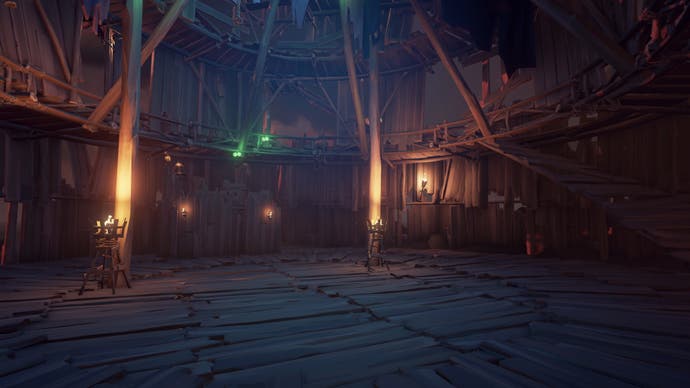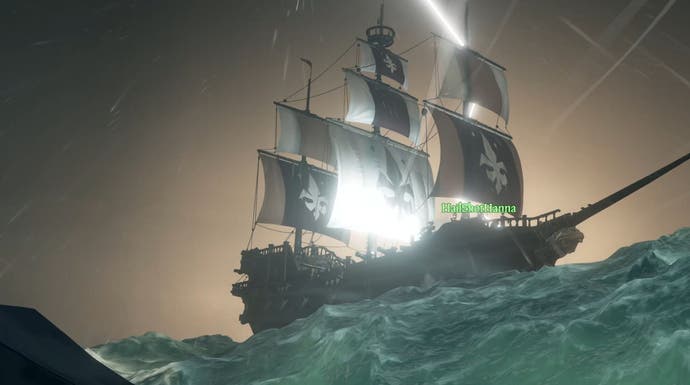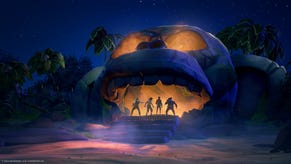How Sea of Thieves' tech creates a unique gaming experience
A Rare technological achievement.
Sea of Thieves offers players a vibrant, cartoon world of stories big and small - but perhaps none of them are as significant as the tale of developer Rare itself. It's hard to believe that Kinect projects aside, it's been over nine years since we last saw a full game from the studio. Much has changed since then, with the studio's reliance on custom, per-game engines replaced by a shift towards Unreal Engine 4. But this game is a title quite unlike any other built on the Epic middleware - Sea of Thieves is beautiful and unique.
From the moment you first begin your adventure it's clear that Rare's latest has a lot to offer visually. With its vast oceans, gorgeous cloud simulation and richly detailed islands, it's an attractive game and it feels like the pre-release media never quite captured its essence. Its open world is hand-built but its rendering is dictated by procedurals to a large extent, from the dynamic time of day transitions and the often dramatic weather simulation through to the varying ocean conditions, there's a light, cartoon style here powered by some serious maths.
We'll take a closer look at the technical make-up of Sea of Thieves a little later on, but let's get the rendering basics out of the way first. After lacking support throughout the entire beta run, Xbox One X functionality is baked into the final code, delivering a full 4K pixel count. Interestingly, the standard Xbox delivers 900p in its final form - a mere 17.4 per cent of the X's rendering throughput, delivering a blurrier output than the pristine presentation of the enhanced console. It's not an unattractive game on the standard Xbox by any means, but X is the place to be for the best experience.
Thankfully, both Xbox One X and Xbox One S deliver HDR rendering and we've got to say that this is one of the most arresting implementations of the technology we've seen to date - contrast is insane, the skyboxes are breathtaking, torches and lanterns are searingly bright and the specular highlights on the ocean look simply sublime in the right conditions. It's simply wonderful, which makes its omission from the PC version of the game a source of intense disappointment - the lack of support essentially means that a Sea of Thieves 60fps experience with HDR is off the table. We've contacted Microsoft to ask why this is the case, but broadly speaking, PC support for high dynamic range generally seems to be stalling while the consoles are thriving.
Thankfully, beyond HDR, all versions of the game share the same underlying visual design. The world of Sea of Thieves is basically divided up into chunks - the sea, the sky, the islands and objects within them. Let's begin with the ocean. A complex, dynamic wave system has been engineered, enabling a wide variety of conditions ranging from a calm, clear ocean to powerful, tempestuous storms. The waves are synchronised between individual systems too, allowing the simulation to line up between each console when playing together online. The ocean exhibits proper foam simulation while light refracts and reflects realistically off its surface, leading to a realistic but highly stylised design. As the sun sets, realistic specular highlights are visible across its surface while light pierces cresting waves. The variation in colour is truly outstanding - and again, HDR is a game-changer.
This is all enhanced with visual effects ranging from the spray of water against your ship while navigating a storm, to water caustics below the surface. Reflections are another interesting point - rather than relying on screen-space reflections, which exhibit plenty of flaws in large bodies of water, Rare opts for what appear to be geometric reflections. Trees and other objects appear with less detail when reflected in the ocean but during normal gameplay, the effect is convincing enough.
If the water is the glue that holds the world together, the islands are the substance that makes it work. Rather than relying on procedural generation, Rare has hand-crafted each island in the game, leading to plenty of variety as you explore. Foliage is placed across most islands with blowing grass, palm trees and bushes spilling out across your path. Beautiful animation is deployed when characters collide with individual plants further enhancing the sense of fluidity. Shadows are adjusted based on the position of the sun and are nicely filtered, even casting realistically across water. The world is further enhanced using an atmospheric haze that gives the impression of light scattering, rising and falling based on the current weather conditions.

The game world makes use of an accelerated real-time time of day system, which makes lighting more challenging. To solve this problem, Rare opted to use light propagation volumes, or LPVs, a technique designed to enable a form of real-time global illumination that relies on lattices and spherical harmonics to represent bounce lighting in a scene. This was first pioneered by Crytek during the last generation but was improved with DX11 and compute shaders by Lionhead for its cancelled Fable Legends game - another Unreal Engine 4 title. It's interesting that Rare has adopted this approach, enabling realistic bounce lighting and occlusion across its world rather than relying on baked lighting to achieve similar results.
Lighting is a key focus for Rare in Sea of Thieves. Screen-space god rays are also applied to the sun, allowing beams to slice through certain scenes. Caves and villages are filled with point lights, enabling some dramatic moments - and this is complemented by the scene geometry. Virtually every edge of each object features undulation or variation in shape lending them a more natural silhouette that plays beautifully with the lighting technology.
Part and parcel of this is the sky rendering, where Rare has conjured its own bespoke solution. Cloud rendering is a difficult problem to solve. Some games take an expensive volumetric approach while others resort to simple two-dimensional plains. Sea of Thieves, however, features fully geometric clouds. Each cloud is built from a simple model that is manipulated in an off-screen buffer and then fed back into the main image. The cloud models themselves are extremely simple, averaging around 850 vertices or thereabouts, but the blurring and distortion performed off-screen allows them to appear soft and fluffy around their edges. The designers can then manipulate the shapes and cloud types to create dramatic formations above the player. Each cloud model is opaque, but the various blending and manipulation applied to can allow clouds to realistically and smoothly overlay one another. But it's really the integration into the lighting system that sells this - we've lost count of the amount of beautiful sunsets we've seen in this title.

Overall, what we have here is a unique, bespoke game that stands apart from the pack and is more than capable of delivering some outstanding moments - but it's far from the complete package and in some areas, extra work is still required. The stylised look of the visuals extends to the enemies dotted throughout the game, but there's a disconnect inherent to combat that leaves these segments feeling somewhat unrefined and laggy - the closest parallel we could come up with is Skyrim's plodding combat. One-on-one fighting is a little unsatisfying ten, but ship-to-ship is another matter entirely - it's tense, suspenseful and success is entirely reliant on good communications between your team, with immense satisfaction gleaned from a successful sinking or boarding.
Good performance is key for Sea of Thieves, but again, there are some issues and currently, they are particularly evident on Xbox One X. Rare has said that it has isolated the issues and will address them in a patch due next week, but in the here and now, we've identified three key areas that exhibit noticeable screen-tearing and slowdown on Xbox One X - and we hope that are list matches up with the developer's.
The first are caves - any sort of tunnel or cave system exhibits severe tearing on Xbox One X and in fact, increased GPU load on the PC. When it happens, the results are quite distracting and lavish point lights aside, there's little logic for why relatively simple scenes should drag so badly. The next challenging spot is found when swimming in small bodies or water or near the shore - particularly when a waterfall is visible. This situation causes similar dips to the caves and is likely at least partially tied to alpha transparencies. Similar dips can also happen when plumes of dust appear after defeating enemies, but more serious are the larger outposts, which are often crammed full of tearing, either in select buildings or just while exploring the outpost itself.

Aside from these trouble spots, however, performance is generally very stable. While sailing the seas with the beautiful water and clouds in full view we rarely encountered drops because of the system. Occasionally, network skips and stutters can cause issues, but tearing is extremely uncommon. It's the same when exploring most islands as well - slowdown and tearing is not a problem. Hopefully Rare's upcoming solution can address this problem.
Then we have the standard Xbox One, which manages to turn in faster performance overall than its enhanced counterpart. You'll still run into noticeable tearing around alpha transparency elements like waterfalls but in general, it's noticeably smoother than the X. This is likely due to the massive resolution differential - in the past, Xbox One games running at 1080p could jump to native 4K on the X while 900p games typically go for 1800p or dynamic resolution. The leap from 900p to 4K may well be significant, especially as the X is also increasing shadow quality and LODs, delivering a visual presentation mostly on par with the PC's top-end mythical settings (minor LOD reductions apart).
PC offers the chance to play Sea of Thieves at 60fps and beyond, but the 30fps frame-rate of the console game could have been enhanced, if object and camera blur had remained active. In the earliest reveal trailer for the game you can see this in action - smooth motion blur is fully engaged and it looks great. Motion blur is a common Unreal Engine feature, so it's disappointing that the developers don't offer it in the options. Motion blur has its own performance penalty of course, but we'd like to hope that at some point it will be introduced as an optional extra.
There is another issue we wanted to mention and that is related to networking - during the first couple of days, we regularly encountered a 'Cyanbeard' error, suggesting that there was a network problem. No other games exhibit this issue, but it happened every 20 minutes like clockwork in Sea of Thieves. We read some suggestions noting that disabling IPv6 on the router would improve the situation but that seem unlikely, right? Well, we did disable it and sure enough, the problem was eliminated entirely and we could play for hours without an issue. If we re-enabled IPv6, however, the issue returned in full force. This shouldn't be necessary, but for those encountering a similar problem, it might be worth trying.
So with week one of the Sea of Thieves experience, what we have here are a small bunch of teething problems taking just a little of the sheen off a great game. Issues are to be expected, but we're hopeful that Rare will be able to resolve them in the short term. From our perspective, ironing out the connectivity issues and making Xbox One X at least as performant as the standard model needs to be the priority. However, this shouldn't detract from what is a unique, massively enjoyable game, shaped as much by teamplay amongst friends as it is by the quest designers at Rare. The technology is equally unique and often beautiful, but it's the fun factor here that sets Sea of Thieves apart - it's a genuine adventure that we highly recommend experiencing.









